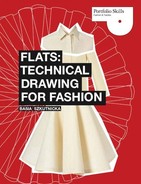HOW TO CREATE FLATS
The process of producing flats, demonstrated here, begins with the creation of a generic body form. This is a basic body shape that can be used as a template, and starting point, for every flat that you make. The next steps involve drawing the garment style. Once you have created a garment style, you can either go on to create the finished flat, or use it as inspiration for drawing a range of styles before selecting those that you wish to develop into final flats. This technique of developing designs through flat drawing is called speed designing (see page 29).
CREATING A GENERIC TEMPLATE
As the first stage in the process of technical drawing it is worth taking some time to draw an accurate generic template, or body shape. Once you have perfected this outline, it may be used as a foundation to produce all your flats. Using a head as a unit of measure, the average female figure is, in real life, seven and a half heads high (see right). For the purposes of technical drawing, to create a more visually appealing silhouette, the body is elongated through the lower section into a figure measuring eight heads (near right, opposite page). It is also useful to draw a side view (far right, opposite page) as some garments may benefit from being drawn from this angle.
You can draw your outline by hand or using cad, or a combination of the two. Since this outline will be used many times, it is worth keeping a master outline in your portfolio for future use or reference. You may find, when working in industry, that you will have different templates for different clients, lines, and markets, depending on their preference. It is important that you bear this in mind when producing work for specific markets.
AVERAGE FEMALE FIGURE

HEADS
LEVELS
GENERIC TEMPLATE
GENERIC TEMPLATE SIDE VIEW
USING A GENERIC TEMPLATE
It is important to understand that one generic template will not be suitable for use at all levels of the industry or in different parts of the world. Body shapes vary from market to market, as well as between different cultures. A female template aimed at the UK or US market might look overweight and too curvaceous to a Far East customer, for example, where the female body shape is different. Garment drawings should reflect the desired market accurately and, therefore, the template needs to be adjusted accordingly each time a different market is attempted. Below is a generic "western" template. Full-size templates (in proportion with the "key basic shapes" in section 2) can be found on the enclosed CD-ROM.
GENERIC TEMPLATE
ADAPTING FOR DIFFERENT MARKETS
The figure, below left, shows how the generic template may be adapted into a "teenage" template, and below right shows a "plus size." The teenage template may also be used for other markets, such as the Asian market, where smaller body frames are indigenous. Knowledge of the differences in markets and body shapes is necessary in order to create aesthetically pleasing templates. If you are designing for a "plus size" market, you would not use your generic template as it is clearly too narrow. The final drawings should reflect the required outcome as much as possible.



